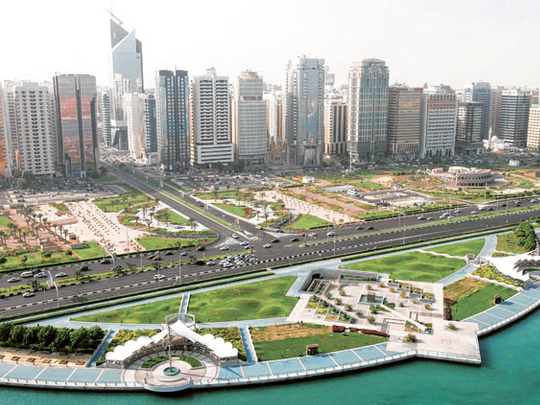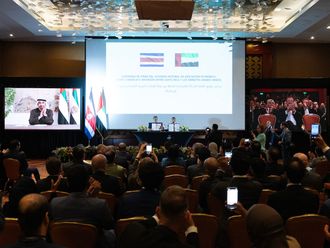
Abu Dhabi: Residents of future urban infrastructure projects in Abu Dhabi will enjoy the cool shade of trees near their residential buildings and intersections where they wait to cross the road.
Landscaping in future projects will be in places where people frequent, a senior official told Gulf News yesterday.
It will also save a lot of water used for irrigation, said Humaid Al Hammadi, associate planner, Abu Dhabi Urban Planning Council (UPC).
According to Abu Dhabi 2030 plan, the emirate's population is expected to grow from the current 1.6 million to about 3 million in 2030.
So several new infrastructure projects will come up to house the increasing population, he said.
At present trees are planted on both sides of the roads as part of city landscaping, he said.
Instead, clusters of trees will be planted near residential areas and intersections where pedestrians wait to cross the road, Al Hammadi said.
Arid environment
It is part of the regulations of Estidama (Arabic for sustainability), a programme designed by Abu Dhabi Urban Planning Council specifically for the hot climate and arid environment in the region. Estidama programme insists on several measures to save water and energy in all infrastructure projects.
Such measures are expected to help reduce Abu Dhabi's per capita water consumption, which is among the world's highest.
All future urban infrastructure projects including Capital District which will house all government offices will follow these principles of Estidama, the official said.
The new landscaping plan will serve two purposes — it will provide shade to people and save a lot of water used for irrigation, the official said.
Explaining the water-saving measures in the new plan, Al Hammadi said, a cluster of trees means the irrigation system has to be arranged locally around that cluster only. "It does not require much water as you don't need irrigation everywhere."
Restriction
At present the irrigation system is a wide network to cover trees on both sides of a long road, which consumes huge amounts of water, he said.
Another water-saving measure is restriction on exotic plants and trees which consume huge amounts of water.
Only indigenous plants and trees which do not need much water will be allowed for landscaping, Al Hammadi said.
The Urban Planning Council (UPC) has developed a Zone Manual, Public Transportation Design Manual [along with Department of Transport] and Industry Design Manual for future infrastructure projects.
UPC is a regulatory body and implements the regulations through several stakeholders such as Department of Municipal Affairs, Environment Agency-Abu Dhabi, Municipality of Abu Dhabi City, and Al Ain and Western Region municipalities in the emirate, he said.
Seat of power
The Capital District will become the seat of power and government for the whole UAE. It will accommodate federal ministries and foreign embassies. It will be 7km inland, south of Abu Dhabi Island, between Mohammad Bin Zayed City and Abu Dhabi International Airport. Capital District will set a new benchmark for the design of a sustainable capital city. It will be planned and designed around the four pillars of sustainability: natural environment, economic development, cultural heritage and social cohesion. This will ensure that Abu Dhabi remains a sustainable and viable capital for future generations. New transport options such as trains and trams and shaded walkways will reduce the impact of cars.
2030 Urban Plan
The Urban Planning Council (UPC) has developed the Abu Dhabi 2030 Urban Structure Framework Plan to optimise the city's development through a 25-year programme of urban evolution. In doing so, it is laying the foundations for a socially cohesive and economically sustainable community that preserves the emirate's cultural heritage. Plan 2030 filters planning decisions through environmental, social and economic development criteria. It presents a practical view of the future though the city's population may grow to 3 million by 2030.
Abu Dhabi 2030 Urban Plan
The Urban Planning Council (UPC) has developed the Abu Dhabi 2030 Urban Structure Framework Plan to optimise the city's development through a 25-year programme of urban evolution. In doing so, it is laying the foundations for a socially cohesive and economically sustainable community that preserves the Emirate's cultural heritage.
Plan 2030 filters all planning decisions through environmental, social and economic development criteria. The city's population may grow to three million by 2030. Regardless. This plan presents a practical, flexible and sustainable view of the future.
Major analysis of social, cultural and economic life in the emirate was conducted alongside workshops involving leading urban planners. The assigned objective is to project a vision of a harmonious society, diversified, culturally rich and evolving in a continuously stable environment. Every element of the UPC's work is underpinned by environmental sensitivity and the desire to protect unique ecology for future generations. To this end, UPC has developed a unique environmental framework in collaboration with the Environment Agency- Abu Dhabi. This framework is called ‘Estidama', which is the Arabic word for sustainability.
Estidama enabled the UPC to create a sustainable four pillar development program, setting out guidelines and regulations
With the recent recognition as one of the top 10 sustainable cities of the future by the Ethisphere Institute, a US based think tank that researches and promotes good government and social responsibility by corporations, Abu Dhabi is on the right path in transforming itself into the sustainable capital of the Arab world.












